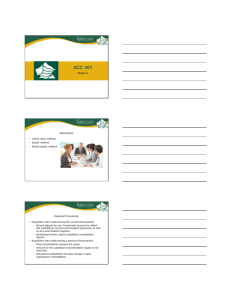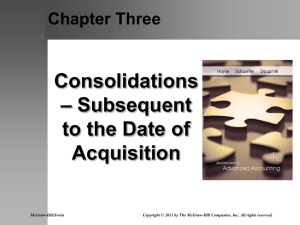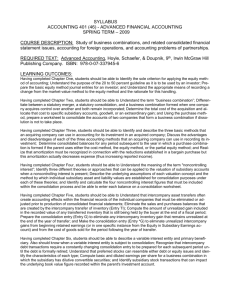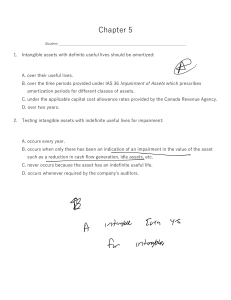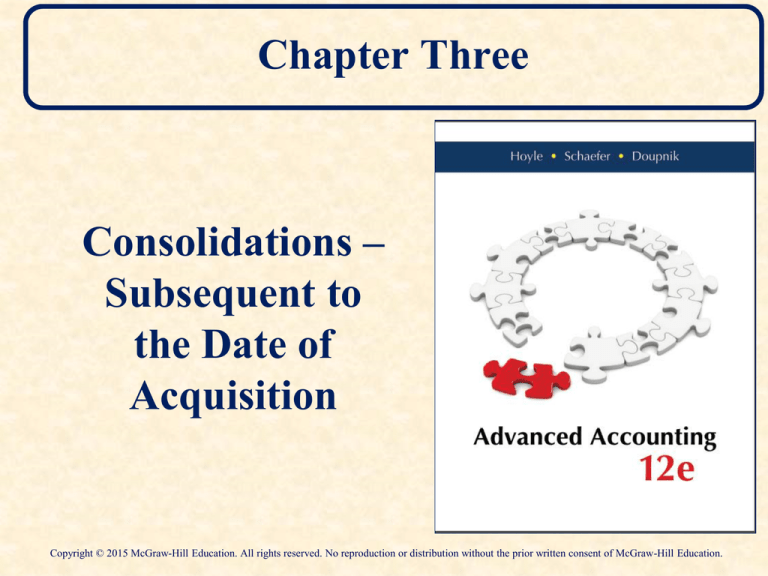
Chapter Three
Consolidations –
Subsequent to
the Date of
Acquisition
Copyright © 2015 McGraw-Hill Education. All rights reserved. No reproduction or distribution without the prior written consent of McGraw-Hill Education.
Consolidation – The Effects
of the Passage of Time
Learning Objective 3-1:
Recognize the complexities in preparing consolidated
financial reports that emerge from the passage of time.
The passage of time creates complexities for internal
record keeping and the balance of the investment
account varies due to the accounting method used.
A worksheet and consolidation entries are used to
eliminate the investment account and record the
subsidiary’s assets and liabilities to create a single set of
financial statements for the combined business entity.
3-2
Investment Accounting
by Acquiring Company
Learning Objective 3-2:
Identify and describe the various methods available to a
parent company in order to maintain its investment in
subsidiary account in its internal records.
An asset account, investment account, and an income
account is created for each subsidiary owned.
The acquiring company selects one of three methods :
Equity Method
Initial Value Method
Partial Equity Method
3-3
Investment Accounting
by Acquiring Company
Comparison of internal reporting of
investment methods.
Method
Investment
Income Account
Equity
Continually adjusted to
reflect ownership of
acquired company.
Income accrued as
earned; amortization and
other adjustments are
recognized.
Initial Value
Remains at InitiallyRecorded cost
Dividends declared
recorded as Dividend
Income
Partial Equity
Adjusted only for accrued
income and dividends
declared by acquired
company.
Income accrued as
earned; no other
adjustments recognized.
3-4
Subsequent Consolidation –
Equity Method
Learning Objective 3-3a:
Prepare consolidated financial statements subsequent to
acquisition when the parent has applied the equity method in its
internal records.
During the year, the parent will adjust its investment
account for the Subsidiary under application of the equity
method. The original investment, recorded at the date of
acquisition, is adjusted for:
1. FMV adjustments and other intangible assets,
2. The parent’s share of the sub’s income (loss),
3. The receipt of dividends from the sub.
3-5
Subsequent Consolidation –
Allocating FMV
PARROT COMPANY
100 Percent Acquisition of Sun Company
Allocation of Acquisition-Date Subsidiary Fair Value
January 1, 2014
FV of consideration transferred by Parrot Company. $ 800,000
Net Book Value of Sun Company. . . . . . . . . . . . . . . . . . .(600,000)
Excess of fair value over book value . . . . . . . . . . 200,000
Allocation to specific accounts based on fair values:
Trademarks . . . . . . . . . . . . . . . . . . . . . . . . . . . . . . . . . . . .$ 20,000
Patented technology . . . . . . . . . . . . . . . . . . . . . . . . . . . . . 130,000
Equipment (overvalued) . . . . . . . . . . . . . . . . . . . . . . . . . (30,000)
120,000
Excess FV not specifically identified—goodwill. . . . . . $ 80,000
3-6
Recording Net Income and Dividends
Assume subsidiary, Sun Company, earns income of $100,000 in
2014 and pays a $40,0000 cash dividend on August 1, 2014.
3-7
Subsequent Consolidation Worksheet Entries
For the first year, the parent prepares five entries on
the workpapers to consolidate the two companies.
S) Eliminates the subsidiary’s Stockholders’ equity account
beginning balances and the book value component within the
parent’s investment account.
A) Recognizes the unamortized Allocations as of the beginning of
the current year associated with the adjustments to fair value.
I) Eliminates the subsidiary Income accrued by the parent.
D) Eliminates the subsidiary Dividends.
E) Recognizes excess amortization Expenses for the current
period on the allocations from the original adjustments to fair
value.
3-8
Applying the Initial Value Method
Learning Objective 3-3b:
Prepare consolidated financial statements subsequent to
acquisition when the parent has applied the initial value method
for internal record-keeping.
Application of either method changes the balances recorded by
the parent over time, but neither affect any of the final
consolidated balances reported.
Just three parent’s accounts vary because of the method applied:
• Investment account.
• Income recognized from the subsidiary.
• Parent’s retained earnings (periods after year of combination).
3-9
Consolidation Entries –
Partial Equity Method
Learning Objective 3-3c:
Prepare consolidated financial statements subsequent
to acquisition when the parent has applied the partial
equity method in its internal records.
For the Partial Equity Method, entry S, A, D, and
entry E are the same as the Equity Method.
Entry I is different using Partial Equity Method:
It eliminates the Parent’s equity in the sub’s income
and reduces the investment account.
3-10
Consolidation Entries –
Other than Equity Method
Entries S, A, and E are the same for all three
methods.
The parent’s record-keeping is limited to two
periodic journal entries:
annual accrual of subsidiary income and
receipt of dividends.
So, the Investment and Income account balances
differ for the other methods, and so will the
worksheet Entries I and D.
3-11
Investment Accounting by Acquiring
Company
Learning Objective 3-4:
Understand that a parent’s internal accounting method for its
subsidiary investments has no effect on the resulting
consolidated financial statements.
The selection of a particular method does not affect the
totals ultimately reported for the combined companies.
The
internal accounting method used does require
distinct procedures for consolidation of the financial
information from the separate organizations.
3-12
Goodwill and Other Intangible Assets
(ASC Topic 350)
Learning Objective 3-5:
Discuss the rationale for the goodwill impairment testing
approach.
FASB ASC Topic 350, “Intangibles-Goodwill and Other,”
provides accounting standards for reporting income
statement effects of impairment of intangibles acquired
in a business combination.
In accounting for goodwill subsequent to the acquisition
date, GAAP requires an impairment approach rather
than amortization.
3-13
Goodwill and Other Intangible Assets
(ASC Topic 350)
Learning Objective 3-6:
Describe the procedures for conducting a goodwill
impairment test.
Once goodwill has been recorded, the value will
remain unchanged until:
1. All or part of the related subsidiary is sold, or
2. There has been a permanent decline in value in
which case we test for impairment and record an
impairment loss if the item is impaired.
3-14
Goodwill Impairment—Qualitative Assessment: Goodwill Impairment Test - Step One
Stop
3-15
Goodwill Impairment—Qualitative Assessment: Goodwill Impairment Test -Step Two
Stop
3-16
Comparison of U.S. GAAP and
International Accounting Standards
Under US GAAP:
Goodwill is allocated to
reporting units, usually
operating segments, expected
to benefit from it.
A two-step process is used to
test for impairment.
If the carrying amount of
goodwill is more than its
implied value, an impairment
loss is recognized.
IFRS Under IAS 36:
Goodwill is allocated to cashgenerating units – at a level
much lower than an
operating segment.
A one-step process is used to
test for impairment.
Goodwill is reduced for any
excess carrying value, down
to zero, and then other assets
are reduced pro-rata.
3-17
Other Intangibles
All identified intangible assets with finite lives should
be amortized over their economic useful life that
reflects the pattern of decline in the economic
usefulness of the asset.
Intangible assets with indefinite lives (extends beyond
the foreseeable future) are tested for impairment on an
annual basis. An entity has the option to first perform
qualitative assessments to determine whether “it is
more likely than not” the asset is impaired.
3-18
Contingent Consideration
in Business Combinations
Learning Objective 3-7:
Understand the accounting and reporting for contingent
consideration subsequent to a business acquisition.
If part of the consideration to be transferred in an acquisition is
contingent on a future event:
The acquiring firm estimates the fair value of a cash
contingency and records a liability equal to the present value
of the future payment.
The liability will continue to be measured at fair value with
adjustments recognized in income.
Contingent stock payments are reported as a component of
stockholders’ equity, and are not remeasured at fair value.
3-19
Push Down Accounting
Learning Objective 3-8:
Understand, in general, the requirements of push-down
accounting and its appropriate use.
Method permits acquired subsidiary to record fair value
allocations and subsequent amortization in its accounting
records.
SEC requires push-down accounting for separate subsidiary
statements if no substantial outside ownership exists. Generally
limited for external reporting, also used internally.
Method simplifies the consolidation process and provides better
information for internal evaluation.
3-20

